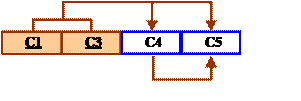Given the dependency diagram shown in Figure Q6.6, answer items 6a-6c:
FIGURE Q5.6 Dependency Diagram for Question 6

a. Identify and discuss each of the indicated dependencies.
C1 ® C2 represents a partial dependency, because C2 depends only on C1, rather than on the entire primary key composed of C1 and C3.
C4 ® C5 represents a transitive dependency, because C5 depends on an attribute (C4) that is not part of a primary key.
C1, C3 ® C2, C4, C5 represents a set of proper functional dependencies, because C2, C4, and C5 depend on the primary key composed of C1 and C3.
b. Create a database whose tables are at least in 2NF, showing the dependency diagrams for each table.
The normalization results are shown in Figure Q6.6b.
Figure Q6.6b The Dependency Diagram for Question 6b
Table 1
 Primary key: C1 Foreign key: None Normal form: 3NF
Primary key: C1 Foreign key: None Normal form: 3NF
Table 2

Primary key: C1 + C3 Foreign key: C1 (to Table 1)
Normal form: 2NF, because the table exhibits the transitive dependencies C4 C5
![]()
a. Create a database whose tables are at least in 3NF, showing the dependency diagrams for each table.
The normalization results are shown in Figure Q6.6c.
Figure Q6.6c The Dependency Diagram for Question 6c
Table 1

Primary key: C1 Foreign key: None Normal form: 3NF
Table 2

Primary key: C1 + C3 Foreign key: C1 (to Table 1)
C4 (to Table 3) Normal form: 3NF
Table 3

Primary key: C4 Foreign key: None Normal form: 3NF